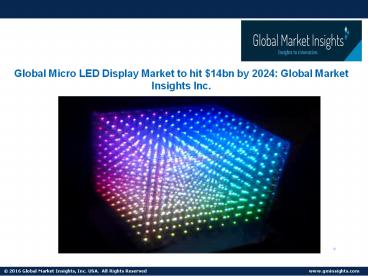Micro LED Display Market to cross USD 14 billion by 2024 - PowerPoint PPT Presentation
Title:
Micro LED Display Market to cross USD 14 billion by 2024
Description:
Request Sample of Report @ The U.S. micro LED display market is expected to witness a significant growth to reach over USD 7 billion by 2024. The growth is attributed to the increasing demand for electronic devices such as smartphones, tablets, and smartwatches. In 2017, the smartwatch sales in the U.S. accounted to approximately 12 million and is projected to increase further. The increasing usage of these components in wearable devices will increase the micro LED display market growth over the forecast timespan. – PowerPoint PPT presentation
Number of Views:97
Title: Micro LED Display Market to cross USD 14 billion by 2024
1
Global Micro LED Display Market to hit 14bn by
2024 Global Market Insights Inc.
Fuel Cell Market size worth 25.5bn by 2024
2
Key Insights from Micro LED Display Market
- Micro LED Display Market size is projected to
surpass USD 250 million in 2018, and is set to
exceed USD 14 billion by 2024 according to a new
research report by Global Market Insights, Inc.
The industry expects shipments of approximately 1
million units by the end of 2018. Increasing
demand for high-performance display solutions in
advanced applications, such as wearable devices
and automotive, will drive the micro LED display
market growth. These energy-efficient devices
potentially reduce the size of the wearable
devices, thus encouraging the device
manufacturers to adopt these components. - The manufacturers are increasingly investing in
the technology development to enhance the
functionality of these components, thus aiding
the micro LED display market size. For instance,
to produce these components, gallium nitride LED
wafers are grown on sapphire substrates. However,
some of the manufacturers are investing in
research for developing gallium nitride on
silicon technology to increase the uniformity in
wavelength and lower the inspection costs. This
will aid in the industry growth.
3
Continued...
- The lack of awareness and inadequate patents in
the industry are expected to restrict the micro
LED display market growth in the short-term.
Inadequate patents in the industry will lead to
the emergence of a large number of counterfeit
products. Due to the newness of the technology
and lack of standard procedures for manufacturing
these components, the threat of the counterfeit
products is low in the short-term but is expected
to increase in the long-term. - Lack of cost-effective procedure for the mass
production of these components is expected to be
one of the major restraining factors in the
market. Currently, the manufacturing process is
only cost-effective for the small-size displays.
However, the manufacturers are working
incessantly to develop a methodology for the mass
production of these devices in variable sizes. - The development of hybrid OLED technology is
expected to hamper the industry growth. In
February 2018, Samsung announced that it is
developing a hybrid QD OLED technology for TV
panels.
4
UK micro LED display market size, by panel size,
2018 - 2024 (USD Million)
5
Browse Full Market Research Report On Micro LED
Display Market _at_ https//bit.ly/2zMODqu
Request for a Sample of this Research Report
_at_ https//bit.ly/2usgCXc
6
Continued...
- The technology, according to the company is
highly efficient for mid-sized video panels such
as TV screens. OLED micro display companies, such
as eMagin, are also investing in research in this
field. This will restrict the growth of the large
micro LED display market. - Small panel size in micro LED display market is
anticipated to grow rapidly to reach revenue
share of over 30 by 2024 due to the surging
demand for small devices such as smartphones,
near-to-eye devices and smartwatches. These
components have several advantages over currently
used OLED technology such as high degree of
luminance, powerful contrast, and low operating
temperatures. - Furthermore, these devices owing to their low
power consumption run for longer a life-span as
compared to the traditional components. This is
encouraging the manufacturers of handheld devices
to increasingly implement these components in the
devices.
7
Continued...
- The Asia Pacific micro LED display market is
anticipated to ship over 250 thousand units in
2018 grow due to the manufacturers of electronic
devices rapidly switching to these components
from the traditional LED or OLED components.
Furthermore, the presence of a large number of
electronic device manufacturers encourages the
display manufacturers in the region to adopt
newer versions of technology to remain
competitive in the industry. - Germany micro LED display market growth will
witness a surge over the forecast timespan due to
the increasing usage of wearable devices in the
country. The consumers are demanding
technologically-advanced and visually-appealing
gadgets as wearable devices. - Wearable device manufacturers are continuously
innovating to develop the product according to
the consumer requirements. Micro LED allow
manufacturers to develop products, such as
smartwatches, making them lightweight, compact,
and energy-efficient.
8
Industry Coverage
9
Companies
- Some of the major companies in the micro LED
display market include Sony, Samsung Electronics,
Apple, Inc., Epistar, Micro Mesa Technologies,
Plassey Semiconductor Technology, VerLASE
Technology, and Glo AB. - The industry is characterized by intense
competition among the players for product
development such as Apple and Sony. For instance,
Leyard Optoelectronics launched a micro LED wall
super small pitch of about P0.9. - The main application of these components is
projected to be indoor surveillance displays,
unlike Sony and Apple that are focusing on
wearable devices applications.
10
Table OF Content
Chapter 1. Methodology and Scope 1.1.
Methodology 1.1.1. Initial data
exploration 1.1.2. Statistical model and
forecast 1.1.3. Industry insights and
validation 1.1.4. Definition and forecast
parameters 1.1.4.1. Definitions 1.1.4.2.
Assumptions, methodology forecast
parameters 1.2. Data Sources 1.2.1.
Primary 1.2.2. Secondary Chapter 2. Executive
Summary 2.1. Micro LED display industry 3600
synopsis, 2018 - 2024 2.1.1. Business
trends 2.1.2. Regional trends 2.1.3. Application
trends 2.1.4. Panel size trends
11
Stay In Touch Website www.gminsights.com Soci
al Media































